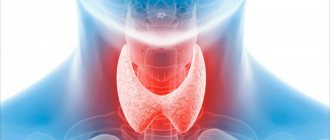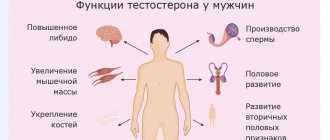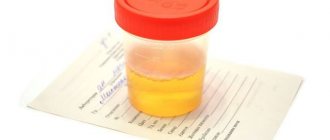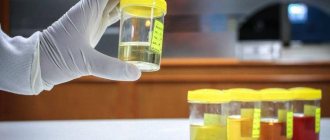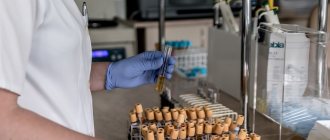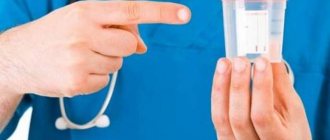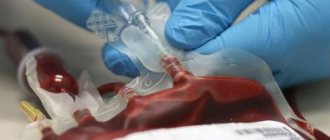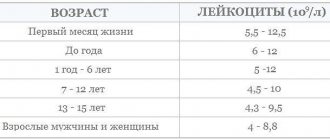Author
Boluchevsky Dmitry Nikolaevich
Chief physician
Leading doctor
Urologist
until January 31
You get 10% cashback when purchasing a gift certificate More details All promotions
Urinalysis according to Nechiporenko
is a laboratory diagnostic method that allows you to determine the condition of the kidneys and urinary tract, in particular, to identify hidden inflammation.
The Nechiporenko analysis is used not only to establish a diagnosis. It can be used to monitor the progress of treatment.
Urinalysis according to Nechiporenko: the essence of the method
Urinalysis according to Nechiporenko
Urinalysis according to Nechiporenko is usually prescribed based on the results of a general urinalysis - if the data from the general analysis exceed the norm. The Nechiporenko analysis will either confirm the existence of the disease or allow the results of the general analysis to be interpreted as a random deviation.
The main indicators of urine analysis according to Nechiporenko - leukocytes, erythrocytes, cylinders - are assessed not simply by counting these elements that are in front of the eyes at the time of the study, as in a general urine analysis. When analyzing according to Nechiporenko, their number is determined per 1 milliliter of urine (counting is carried out using a special counting chamber).
It is also important that a strictly average portion of morning urine should be taken for analysis. This allows you to exclude the influence of random factors and get a picture of the real state of the urinary system.
It is equally important that the collected material reaches the laboratory within two hours.
All this together makes urine analysis according to Nechiporenko an informative and accurate diagnostic method.
Indications for testing
The main indication for prescribing a urine test according to Nechiporenko for adults and children is the detection of deviations in the results obtained after a general urine test. The study can confirm the development of a certain pathology or classify deviations from the norm as random.
Indications for urine analysis according to Nechiporenko are the appearance of symptoms that may indicate the development of serious pathologies. This is, first of all, cloudiness of the urine, as well as a change in its color and smell. The study is also prescribed in the following cases:
- If you experience pain in the lumbar region, which may indicate kidney problems.
- When changing the frequency of urination and the amount of urine.
- If blood is detected in the urine.
- For systemic diseases that increase the risk of renal dysfunction.
- During preventive examinations.
Mandatory tests include urine analysis according to Nechiporenko during pregnancy. It allows you to promptly detect malfunctions in the functioning of the urinary system. Thanks to this, it will be possible to purchase the necessary products at an affordable price to support a woman’s body while bearing a child.
Urinalysis according to Nechiporenko: indicators and norms
Leukocytes
- white blood cells. They perform a protective function by producing antibodies and absorbing bacteria. An increased number of white blood cells means that the body is reacting to an existing source of inflammation. The norm for the Nechiporenko test: up to 2000 per 1 ml of urine.
Red blood cells
– red blood cells (they give the color to blood). Their function is to transport oxygen, and they should not be present in significant quantities in urine. An increased number of red blood cells is called hematuria (can be translated as “blood in the urine”). The presence of blood in the urine in some cases is obvious (that is, detected visually), but a slight increase in the number of red blood cells (hidden hematuria) can only be recognized by laboratory methods. The norm for the Nechiporenko test: up to 1000 red blood cells per 1 ml of urine.
Cylinders
- these are casts, that is, stuck together, compressed elements that appear only in the presence of protein. The protein, coagulated in the acidic environment of urine, forms an adhesive base that unites other elements. Casts arise in the renal tubules. Their appearance in the urine directly indicates kidney pathology, since in a healthy person protein should not get into the urine. The norm for the Nechiporenko test: no more than 20 cylinders per 1 ml of urine.
Bacteria
- Normally they should not be in the urine.
Microscopic examination with quantitative counting of leukocytes, red blood cells and casts in 1 milliliter of urine sediment.
Synonyms Russian
Determination of the amount of blood cells in urine sediment, Nechiporenko’s test.
English synonyms
Urinalysis, Urine test, Urine analysis, UA, Microscopic Examination, Urine.
Research method
Microscopy.
Units
Cells/ml (cells per milliliter), Units/ml (unit per milliliter).
What biomaterial can be used for research?
An average portion of morning urine.
How to properly prepare for research?
- Do not eat spicy, salty foods, or foods that change the color of urine (for example, beets, carrots) for 12 hours before the test.
- Avoid taking diuretics for 48 hours before urine collection (in consultation with your doctor).
General information about the study
Urinalysis according to Nechiporenko allows you to more accurately determine the quantitative content of red blood cells, leukocytes and casts than a general clinical urine test. Both studies are carried out using microscopy, but in the Nechiporenko test, elements are counted per unit volume of liquid, and not by the number of cells or cylinders in the field of view.
Normally, the renal glomeruli do not allow blood cells and albumin to pass through, but in some diseases the renal barrier is damaged, which is reflected in changes in the composition of urine. The presence of a large number of red blood cells in the urine (hematuria) may indicate damage to the glomerulus. It must be taken into account that blood cells in the urine are found in cases of damage, stones, inflammatory diseases or neoplasms at all levels of the urinary tract - blood enters there from the renal pelvis, ureter, bladder or urethra. The renal origin of hematuria is indicated by the identification of red blood cell casts or leached red blood cells.
Normally, leukocytes are present in urine in small quantities. Their content may increase in inflammatory diseases of the urinary system, genitourinary tract infections and some acute inflammatory systemic diseases. Leukocytes are able to penetrate to the site of inflammation through intact tissue. If they are excessively isolated - leukocyturia - it is necessary to conduct a bacteriological examination of urine to clarify the etiology of the disease and prescribe adequate therapy.
In clinical practice, the definition of leukocyturia or hematuria is often used in the differential diagnosis of glomerulonephritis and pyelonephritis.
Casts are protein conglomerates that are produced from cells and cellular detritus when the physicochemical properties of urine change. They form in the renal tubules and take their shape. Epithelial cells of the tubules form epithelial casts; when epithelial cells and leukocytes are destroyed, granular casts appear; wide waxy casts are formed from degenerating granular casts. Their detection indicates severe kidney damage, the development of renal failure and an unfavorable prognosis of the disease. Hyaline casts form from proteins and often indicate proteinuria. Their formation involves the protein Tamm-Horsfall protein, which is normally present in the renal tubules in dissolved form and is important in the immunological protection of the organ from infection. Hyaline casts can also be found in a healthy person after intense physical activity or with minimal pathological changes in the kidneys.
What is the research used for?
- For the diagnosis of acute and chronic inflammatory diseases of the urinary tract (pyelonephritis, glomerulonephritis, cystitis, urethritis).
- To evaluate kidney damage in certain systemic diseases (eg, diabetes mellitus, systemic lupus erythematosus, amyloidosis, vasculitis, and trauma).
- For differential diagnosis of urinary tract diseases.
- To monitor the treatment of diseases of the urinary organs.
When is the study scheduled?
- For symptoms of pathology of the urinary tract (changes in color, smell, transparency and amount of urine, frequency of urination, pain in the lumbar region, lower abdomen, when urinating).
- In case of questionable results or abnormalities in the general urine analysis.
- For systemic diseases with a high risk of damage to kidney function.
- During preventive studies.
- When monitoring the effectiveness of treatment of urinary tract diseases.
What do the results mean?
Reference values
| Component | Reference values |
| Leukocytes | 0 – 2000 cells/ml |
| Red blood cells | 0 - 1000 cells/ml |
| Cylinders: hyaline | 0 - 20 U/ml |
| Cylinders: grained | 0 - 20 U/ml |
| Cylinders: waxy | 0 - 20 U/ml |
| Cylinders: others | 0 - 20 U/ml |
Reasons for the increase in indicators
Red blood cells
- Kidney infarction.
- Glomerulonephritis.
- Urolithiasis disease.
- Hemorrhagic cystitis.
- Tubulointerstitial nephritis.
- Polycystic kidney disease.
- Severe pyelonephritis.
- Kidney injury.
- Kidney tuberculosis.
- Kidney tumor.
- Renal vein thrombosis.
- Benign familial hematuria, benign recurrent hematuria.
- Benign prostatic hypertrophy.
- Hemophilia.
- Congestive heart failure
- Subacute infective endocarditis.
- Systemic lupus erythematosus.
- Urinary tract infection.
- Leukemia, thrombocytopenia.
- Vasculitis.
- Collagenoses.
- Goodpasture's syndrome.
- Malignant hypertension.
- Scurvy (vitamin C deficiency).
Leukocytes
- Acute pyelonephritis.
- Cystitis.
- Glomerulonephritis.
- Nephrotic syndrome.
- Kidney tuberculosis.
- Systemic lupus erythematosus.
- Bladder tumor.
- Appendicitis.
- Acute pancreatitis.
- Fever.
Epithelial casts
- Acute necrosis of the renal tubules (kidney infarction).
- Eclampsia.
- Glomerulonephritis.
- Heavy metal poisoning.
- Tubulointerstitial nephritis.
Hyaline casts
- Nephrotic syndrome and proteinuria.
- Pyelonephritis.
- Intense physical activity.
- Chronic renal failure.
- Glomerulonephritis.
- Congestive heart failure.
- Diabetic nephropathy.
- Malignant hypertension.
- Fever with dehydration, overheating.
- Emotional stress.
Waxy cylinders
- Chronic kidney disease.
- Diabetic nephropathy.
- Amyloidosis of the kidneys.
- Malignant hypertension.
- Kidney transplant rejection.
- Nephrotic syndrome.
- Lipoid nephrosis.
- Paraproteinuria in myeloma.
Grainy cylinders
- Acute renal failure.
- Chronic mercury poisoning.
- Chronic renal failure.
- Glomerulonephritis.
- Malignant hypertension.
- Pyelonephritis.
- Kidney tuberculosis.
- Toxicosis of pregnant women.
- Intense physical activity.
What can influence the result?
- Hematuria sometimes occurs with intense physical exertion or trauma to the urethra with a catheter. Red blood cells can be found in the urine when menstrual fluid or hemorrhoidal bleeding gets into it.
- Drugs that can cause hematuria: alteplase, acetylsalicylic acid, amphotericin B, bacitracin, warfarin, BCG vaccine, danazol, ibuprofen, indomethacin, itraconazole, candesartan, clopidogrel, methenamine, methicillin, mefenamic acid, misoprostol, penicillamine, phenylbu tazon, salicylates, sulfonamides.
- Medicines that reduce hematuria: ascorbic acid, captopril, finasteride, lamotrigine.
Peculiarities
The analysis involves examining urine sediment. To do this, the biomaterial is poured from a sterile container into a test tube and mixed. After this, the vessel is placed in a centrifuge and the sediment is separated. After this, it is carefully examined in a volume of 1 ml in a chamber equipped with a special counter. The obtained data is multiplied by the provided coefficients to correctly reflect the level of structures.
Violations of the rules for urine collection most often lead to unreliable results. The risk of data distortion increases when storing biomaterial in non-sterile containers.
Analysis reference values
Urine analysis is interpreted by comparing the results obtained with accepted standards. These studies are not classified by gender. The standards for boys and girls are the same. According to Nechiporenko's table, the reference values for leukocytes are 2000/ml. Exceeding the norm is called leukocyturia.
The permissible upper limit of red blood cells is no more than 1000/ml. An increase in concentration is diagnosed as hematuria. The presence of hyaline casts is limited to 20/ml. The presence of erythrocyte, epithelial, granular and waxy casts or increased values of hyaline casts is called cylindruria.
Deviations in the corpuscles in the final analysis data indicate pathological changes in the functioning of the urinary organs.
Preparing for the Urinary Bladder Cancer (UBC) Antigen Test
With malignant degeneration of the epithelium of the bladder, its walls intensely secrete the so-called cytokeratins. Determining them in urine is a reliable screening method for diagnosing cancer of this organ. For the study, a single portion of urine is taken. No special preparation is required, but two days before the test it is advisable to stop all diuretics, having agreed with your doctor. It is not recommended to conduct research in the presence of acute inflammatory processes of the genitourinary system.
You can submit your urine for the necessary analysis in any medical office. Our specialists are always ready to advise on how to properly prepare for a particular analysis in order to obtain the most reliable result. Skylab is:
- Comfortable. Ten laboratories located in different areas.
- Fast. The results of the study can be found on the website without leaving your home.
- Reliable. We use modern diagnostic equipment, which ensures high accuracy of analysis.
Given these advantages, the prices for our services are relatively low and affordable for the vast majority of patients.
Preparation for 24-hour urine testing
Pre-prepare a clean container for collecting urine with a volume of at least 3 liters, into which you will collect biomaterial throughout the next day.
Collection technique:
- In the morning, completely empty your bladder, then collect all subsequent portions of urine into a prepared container exactly until the same time the next day.
- During collection, store the container with urine in a cool, dark place at a temperature (+4...+8°C).
- After collecting daily urine, mix it thoroughly and pour about 50 ml into a disposable plastic container; indicate on the label the exact volume of urine excreted per day (for example: “Diuresis 1500 ml”).
- Screw the lid on the container and deliver the biomaterial for research.
Preparing for the Zimnitsky test
The Zimnitsky test is performed to assess kidney function—their ability to concentrate and excrete urine. The study differs from others in the method of collecting material. In total, you need to receive 8 portions of the material strictly at a certain time. At 6 a.m. you need to urinate, after which, starting at 9 a.m., collect urine into labeled containers every 3 hours. All urine obtained, without mixing, must be brought to the laboratory. In addition, you need to indicate how much liquid was taken during the day. It is necessary that the total volume of liquid drunk is within 1-1.5 liters.
Preparing for the 17-KS analysis
17-ketosteroids are metabolic products of sex hormones that are excreted in the urine and reflect the level of androgen production in the body. The analysis is used in the diagnosis of hormonal disorders and tumors of the endocrine glands. For research, daily urine is collected according to general rules. No special preparation for analysis is required. Before collecting urine, if possible, stop taking medications 2-3 days before, and do not eat foods that can color it the day before (for example, beets, carrots, etc.). It is recommended to maintain physical and psycho-emotional rest. All of the above is also true for testing urine for other hormones.
